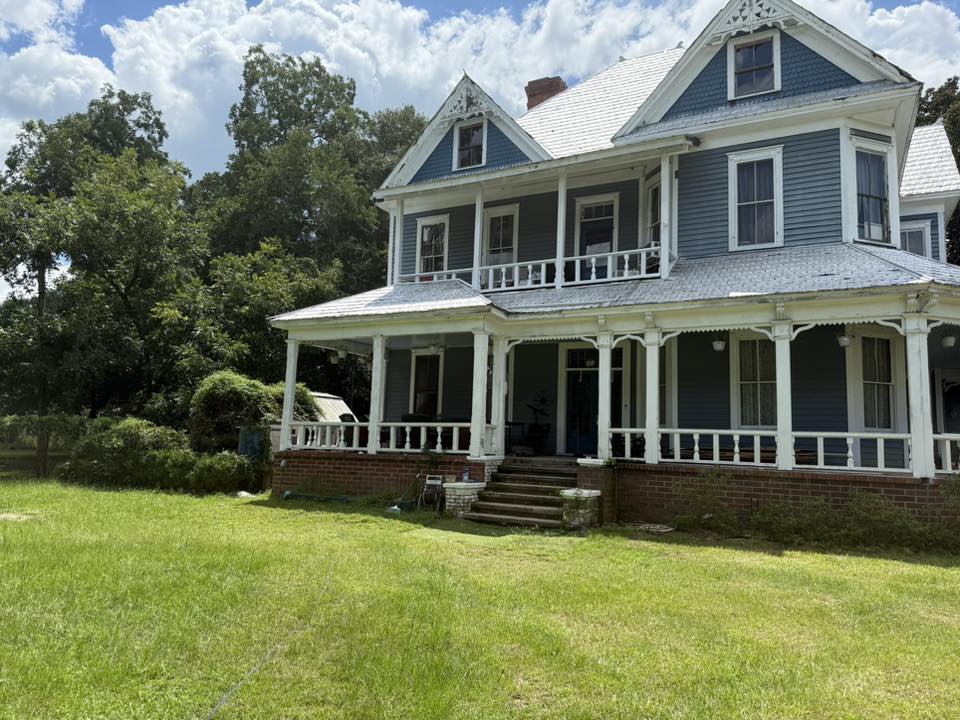
Location: 420 S Main St. in Ashburn, Georgia
Date: August 26, 2025
Photo by current owners
Ashburn’s Historic Driving Tour Stop #10
This home is known as the Evans House because this two-story Victorian home was built by Ashburn entrepreneur John West Evans (September 27, 1844 – January 16, 1904) and his wife Ella Bohannon Evans (December 27, 1852 – February 22, 1910) who were married September 27, 1871, before coming to Ashburn.
It was designed by Macon architect P.E. Dennis. He had his hand in designing many of Turner County’s beloved buildings such as the Methodist Church and the Courthouse. It was completed in 1897. The house was built with local heart pine. Per the local newspaper, The Ashburn Advance, the cost of the home was ~$6000. (Ashburn Advance, 7/6/1897)
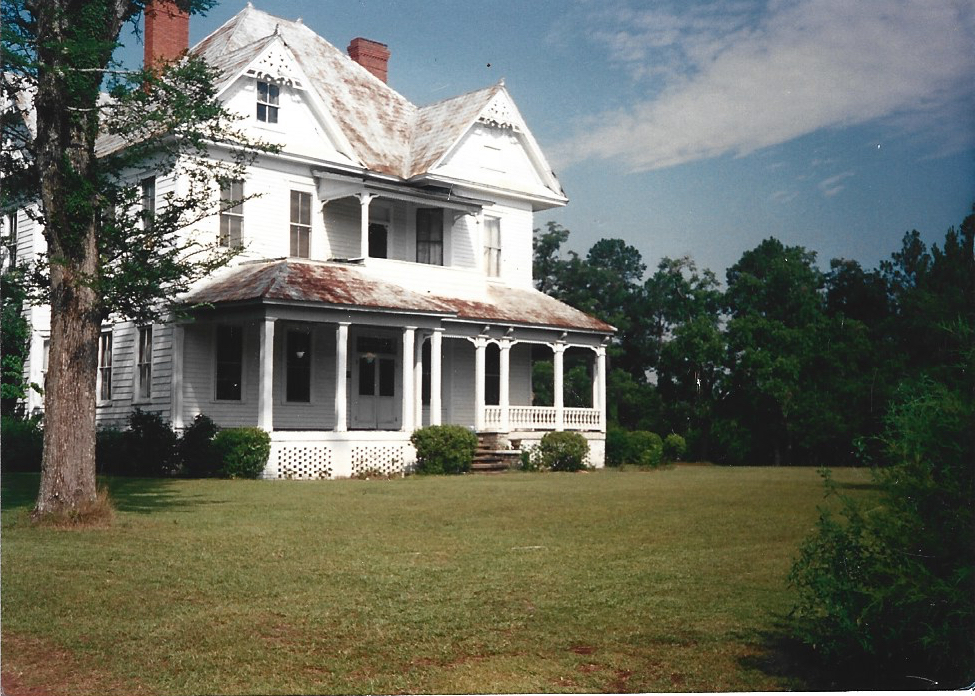
Jump to Section:
- The Evans family
- John West Evans (September 27, 1844 – January 16, 1904)
- Ella Bohannon Evans (December 27, 1852 – February 22, 1910)
- George Sterling Evans (September 3, 1872 – November 11, 1903)
- John Lamkin Evans (July 10, 1874 – December 6, 1934)
- Charity Victoria Evans (October 4, 1876 – May 19, 1955)
- Aurena Emmie Josephine Evans Burgess (July 22, 1880 – March 2, 1974)
- Ella Mary Evans Rogers (June 3, 1884 – January 14, 1983)
- Samuel “Sammie” James Evans (March 2, 1888 – September 16, 1974)
- Is the Evans House Haunted? The story of the Azzie Martin murder.
The Evans Family
John West Evans
(September 27, 1844 – January 16, 1904)
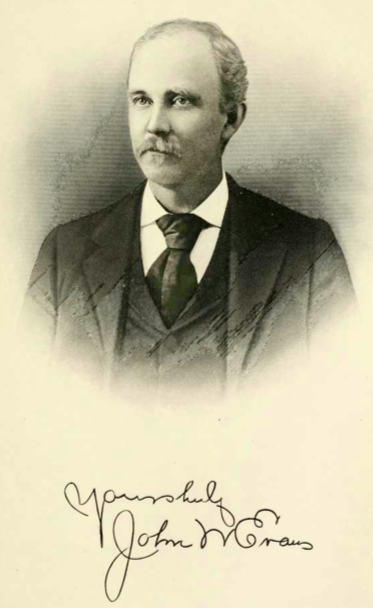
Born in Hancock County to Sterling G. and Mary West Evans, John and his wife Ella, followed his business partner/brother-in-law John Samuel “J.S.” Betts (July 29, 1848 – April 25, 1918) and moved to Turner County in 1888 before it was even known as Ashburn or Turner County. John soon established himself as one of Turner County’s most entrepreneurial and civically active citizens. He was a leader in establishing the town as we know it. John was a bookkeeper for the firm and a prominent partner in the J.S. Betts Company which brought a lot of interest to the area with their sawmill. He also had his hand in the Betts-Evans Trading Company and Evans Realty Co. When the first post office was opened in Ashburn, he served as the first postmaster. He was also the Sunday school superintendent of the Methodist Church.
“He had the wisdom twenty-five years ago to see that there had come a golden age for the lumber business, and forsook a good position to try his hand in a field of larger opportunity. He built up a great enterprise and made much money, and in doing of this was a chief factor in the building up of one of the best towns of South Georgia, and enabling a large number of men to make an [sic] hundredfold more than he made for himself. Not only did he make two blades of grass grow where one grew before, but he made many blades to grow where none grew before, and served his generation well.” To read more about John West Evans, check out Men of Mark in Georgia Volume 6 (covering the period of 1733-1911), pages 224-226.
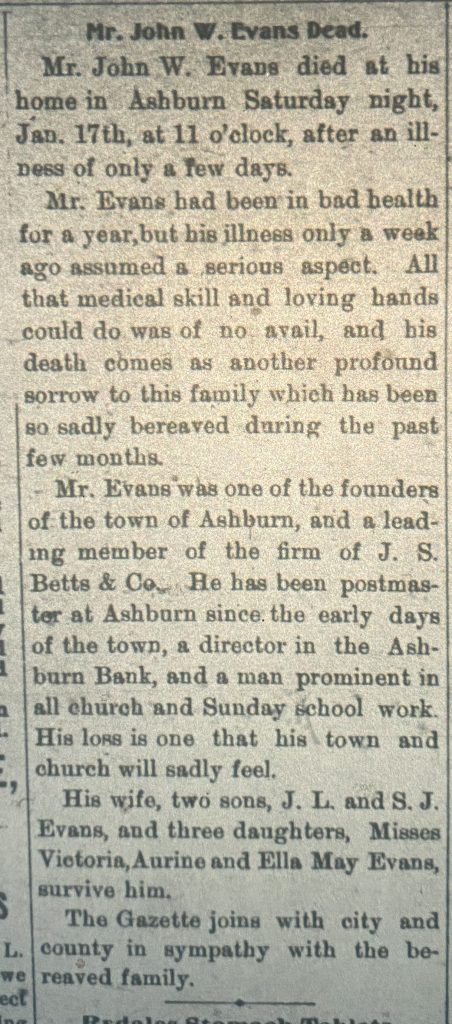
January 22, 1904
Ella Bohannon Evans
(December 27, 1852 – February 22, 1910)
Ella Bohannon Evans, daughter of extensive planters James Bohannon of Dodge County, married John West Evans (September 27, 1844 – January 16, 1904).
Unfortunately, there is not much known about Ella Evans which is typical of the time. According to her obituary in The Turner County Banner on February 25, 1910, she was “a splendid character, of a bright and cheerful disposition and loved by all who knew her.” She passed away after suffering from Brights Disease, more commonly known today as kidney disease.
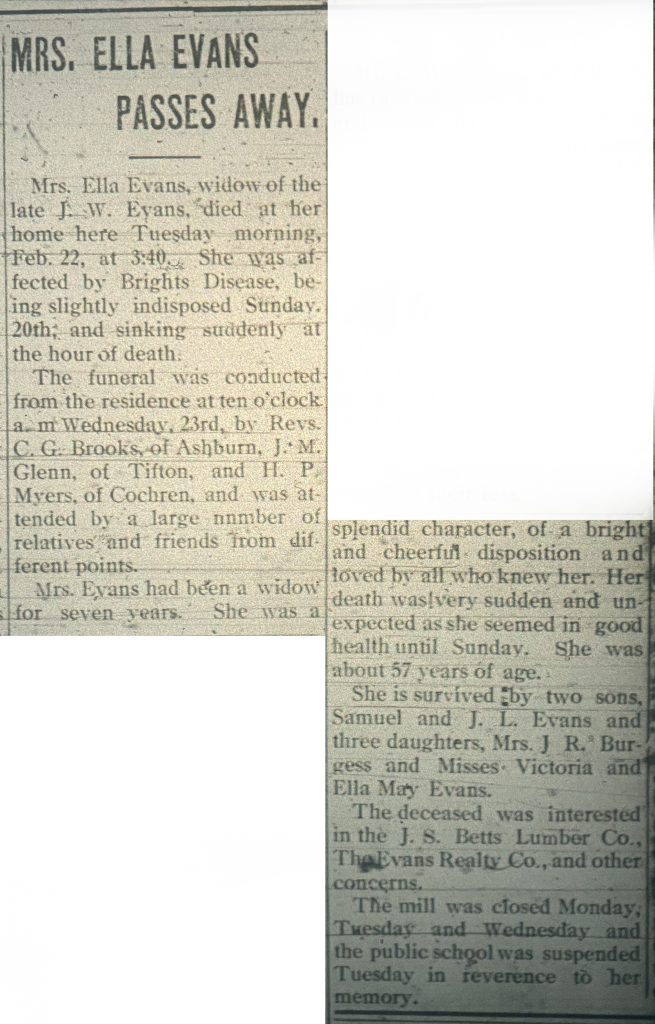
February 25, 1910
George Sterling Evans
(September 3, 1872 – November 11, 1903)
George was very active in the family businesses. He was a superintendent at the sawmill according to the 1900 census. He died at age 31.
John Lamkin Evans
(July 10, 1874 – December 6, 1934)
After the untimely death of his brother George, John L. Evans took over the management of the sawmill and was engaged in extensive farming in later years. He was married to Florrie Benton Smith (September 22, 1873 – October 1, 1955) of Sycamore, Georgia. He was very active in all civil and church interests, especially at the Ashburn United Methodist Church where he took over his father’s role:
“Mr. J. L. Evans served faithfully as Sunday School Superintendent beginning the year 1905, when he succeeded his father, Mr. J.W. Evans. The younger Mr. Evans served until 1934, the longest period of time that any member has served in this capacity. His daughter, Mrs. Josephine Evans Miller, recalls that he had regular monthly meetings of his Workers’ Council to plan and motivate the work of the Sunday School. These meetings were held in his home, and Mrs. Evans always served refreshments which certainly must have kept these sessions from being the proverbial ‘tedious and tasteless’ hours. Mrs. Miller fondly remembers that her mother called them ‘Papa’s Prayer Parties.’ Mr. Evans’ concern for the work must have been very deep because Mrs. Miller says that at the beginning of each school term he went to the public school to talk to the children and enroll prospective Sunday School members…” (From Sawdust to Sanctuary: 1889-1976, A History on Ashburn Methodist Church, pg. 11. A copy of this work can be found at the Tift County Public Library in the Genealogy Room.)
But as mentioned, John was majorly involved in several businesses that were prominent in Turner County. He was also a major investor and Vice President at the Ashburn Oil Mill with J.S. Shingler in 1910, a major investor and Vice President at the Turner County Bank with Shingler in 1912, and Vice President of the Betts-Evan Land Co., which was a large-scale 2,000-acre farm that produced cotton, cantaloupes, and watermelon. He was also heavily involved in the Ashburn Lumber Company, per the Wiregrass Farmer, March 14, 1914 edition: “One of the big, comprehensive and useful industries of this section of the state is the Ashburn lumber company, which was established under its present management two years ago. This establishment is a model of its kind. The equipment is of the most modern. Mr. J.L. Evans, a skilled lumber and mill man, and one of the leading businessmen of this community is the proprietor and general manage of the business.”
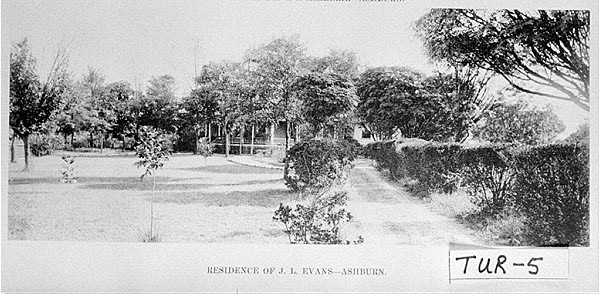
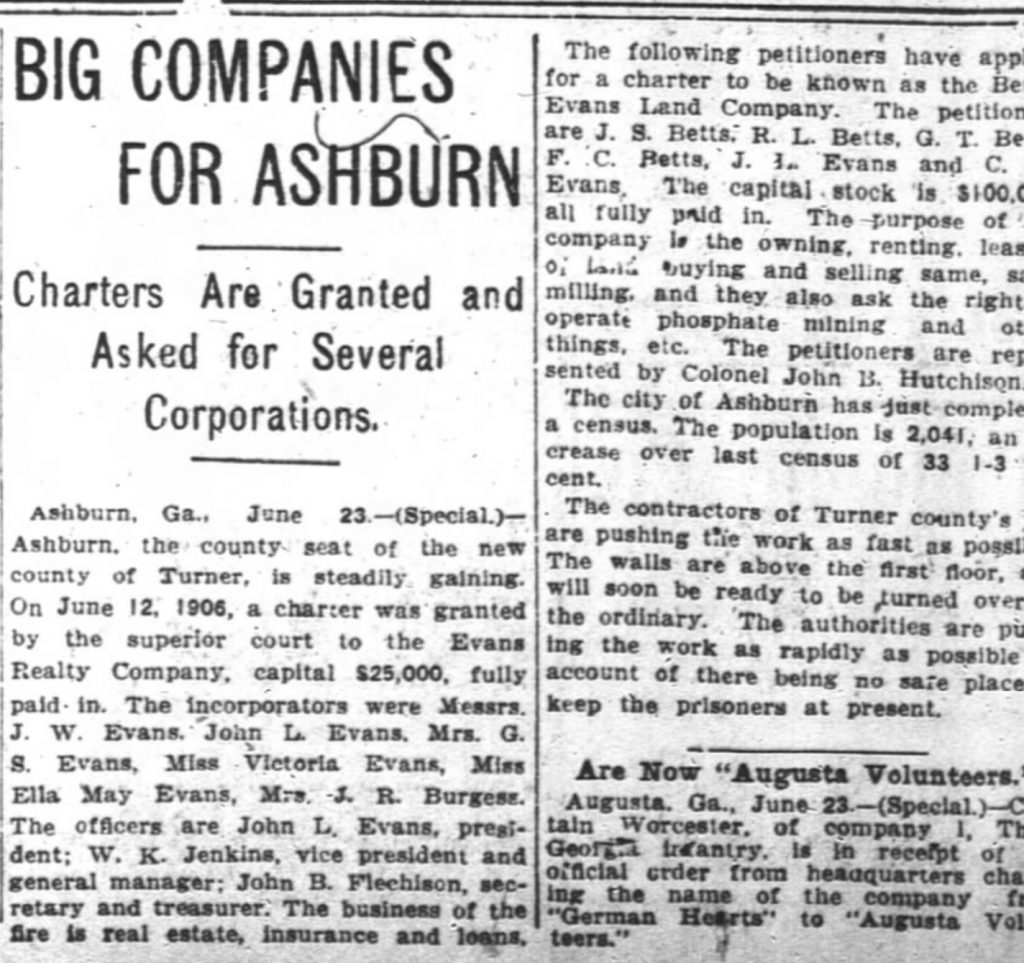
Charity Victoria Evans
(October 4, 1876 – May 19, 1955)
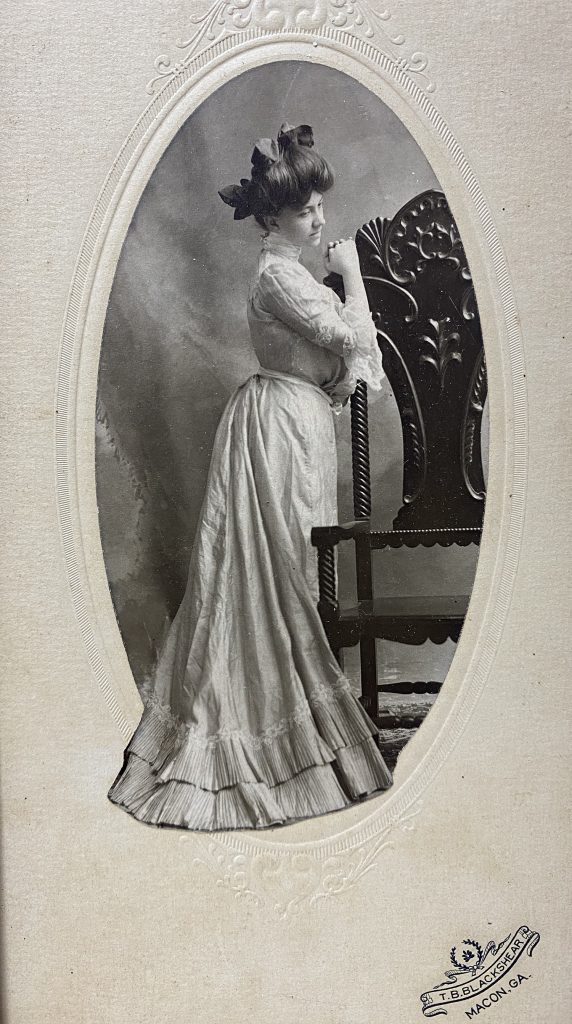
Victoria Evans, also commonly called Miss Vic, moved to Ashburn at age 13 with her family. Much like the rest of her family, she was very active in the community. She never married so she devoted her time to the betterment of the area. At an early age, she stepped in as a Sunday School teacher to a class of unruly boys. She was a charter member of the Ashburn Women’s Club and was president for 6 1/2 years. She was Ashburn’s first librarian from 1932-1952, which earned her the honor of the library being named after her. On an interesting note, according to the 1940 census, her salary for the year was $618.00.
According to her obituary posted in The Wiregrass Farmer on May 26, 1955, “Throughout her life, she shared abundant knowledge and wisdom with others through community work. When the Ashburn Women’s Club was organized in 1921, Miss Vic served for six and one-half years as the club president, undertaking and succeeding in carrying out some of the organization’s most outstanding achievements. She was really the inspiration of Ashburn’s library, founded by the Ashburn Women’s club. For twenty years, Miss Vic was a librarian at the Ashburn public library. In 1954, the library was named Victoria Evans Memorial Library in honor of her service to the library and the community, “because of her love for education, she was mainly responsible for building the library from a small beginning to a worthy institution, serving often without remuneration… Her most outstanding characteristics was her love for the church, and her wit, charm, and warm friendship which remained bright even in her twilight years.”
Aurena Emmie Josephine Evans Burgess
(July 22, 1880 – March 2, 1974)
Aurena Evans was born in Dodge County and moved to Ashburn in her early childhood. She became very active in the First United Methodist Church of Ashburn. Eventually, she met and was married to James Rowland Burgess, and they went on to have 8 children.
In her obituary March 4, 1974 in The Wiregrass Farmer, Aurena “exemplified Christian loyalty and dedication.”
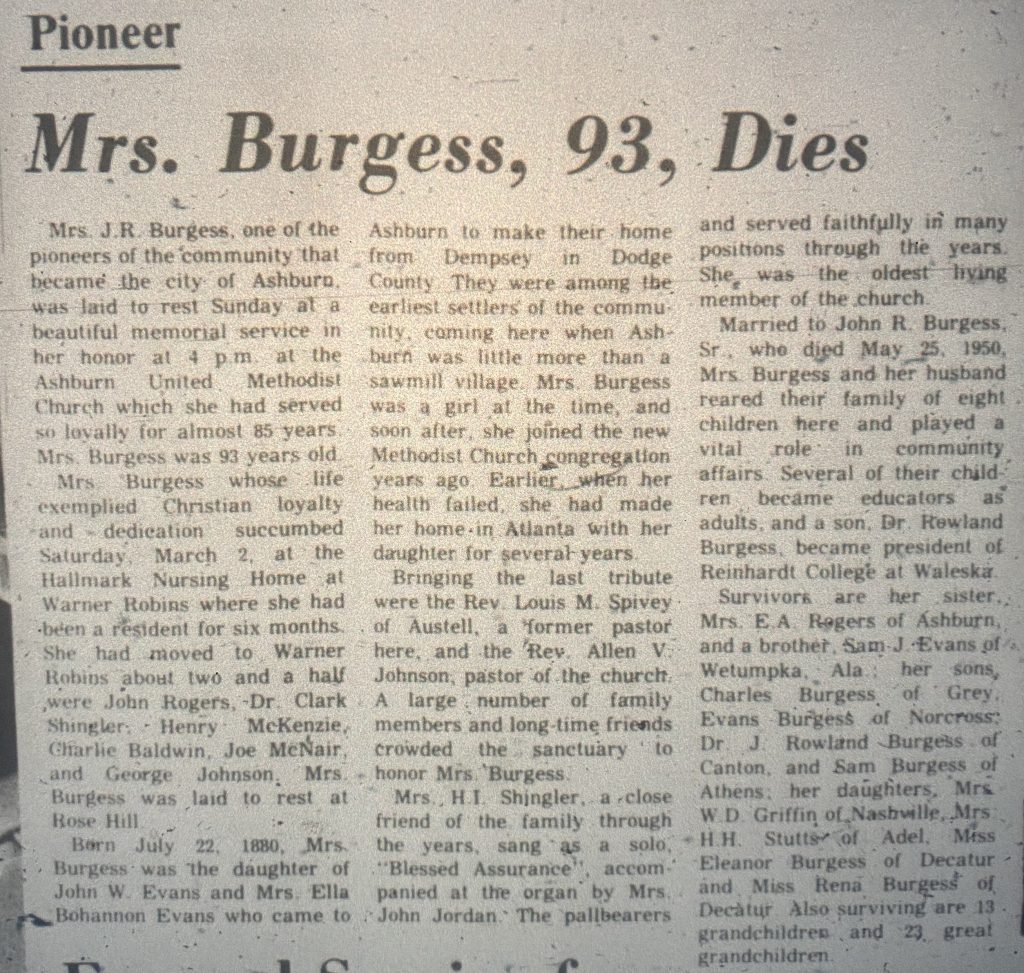
Ella Mary Evans Rogers
(June 3, 1884 – January 14, 1983)
Ella Mary “Mae” Evans married to Col. Edwin A. Rogers (January 15, 1881 – August 10, 1954), on October 27, 1910. He was a city attorney and eventually became president of the Betts-Evans Land Co. with John, his brother-in-law set up as the vice president. Edwin Rogers passed away unexpectedly by a cerebral hemorrhage while two of his daughters were traveling in London, England.
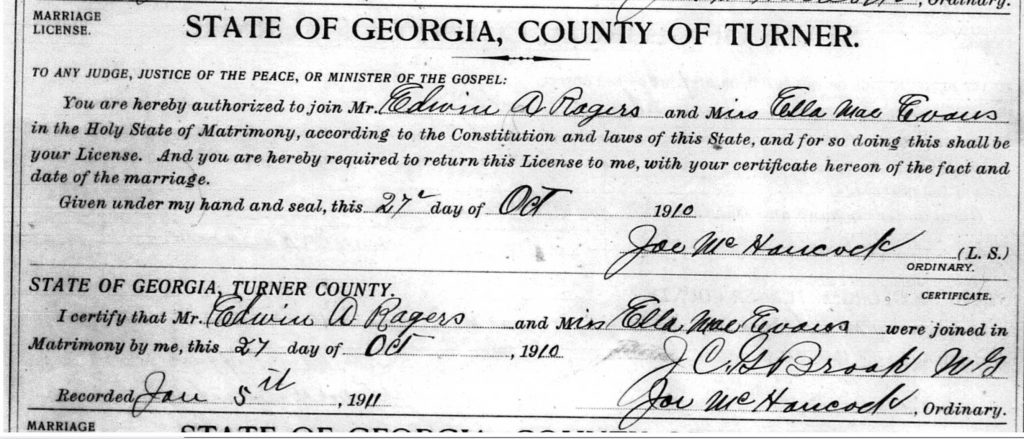
Samuel “Sammie” James Evans
(March 2, 1888 – September 16, 1974)
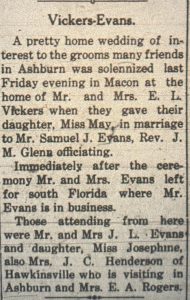
Samuel, the youngest son of John and Ella Evans, was just as active in different jobs as the rest of his siblings. He worked as an accountant, moved onto to become a “proprietor and manager of The Ashburn Grocery Company, the only wholesale grocery house in this section of the country…” (The Wiregrass Farmer, March 13, 1914), a bookkeeper, and eventually sales. He moved to Thomasville, Georgia sometime before 1940 and eventually ended up in Wetumpka, AL. On November 24, 1916, Sammie married to May Vickers (October 4, 1895 – June 11, 1962).
Is the Evans House haunted?
The Evans house has the dubious distinction of being considered haunted. In 1937, Florrie Benton Smith Evans (9/22/1873 – 10/1/1955), the daughter-in-law of John West Evans, was living in the downstairs portion of the Evans house and renting the second floor as an apartment to a young lady in her early twenties. The young lady decided to host a Christmas party and invited some prominent young residents of Ashburn as well as a few out-of-town guests. She hired Azzie Martin (note: name has been recorded as Essa and Azza, but per her niece Donna Bateman, her name is actually Azzie Martin), a local resident, as her cook and helper for the evening. The midnight Christmas party got out of hand in the early morning hours, and Azzie Martin ended up missing, with her remains found 3 months later out in the country.
There are many different versions of what happened, and unfortunately, the only official record available is the newspaper recap, which claims Azzie was drunk and hit her head. However, other versions that are hearsay have said she had been hit in the head with a beer bottle by a fellow party-goer due to her refusal to serve them topless. It is said that the guilty party covered up their crimes by taking her body wrapped in a rug and disposing of it either themselves or by a gentleman named H. Worthy.
Her bones were found 3 months later near Little River by some turpentine workers. An investigation was held, but no formal charges were ever brought forward. They say that Azzie haunts the house and is seen most frequently on the staircase and that her steps are often heard on the second floor. However, current owners have never heard any strange noises aside from the rogue squirrel.
Oral history interview discusses Azzie Martin Murder
This interview is part of the Turner County Art Council/Ashburn Historic Preservation Commission Oral History Project.
In an 2003 oral history interview with Edgar Perry, H. Paul Perry, and Charles B. Perry (all at that time, owners of Perry Funeral Chapel) conducted by then Chamber President Shelley Zorn and local historian Gail Walls, their story slightly changed the narrative:
Shelley: Tell us what you know about the Evans House that’s supposed to be haunted.
Paul: There’s some apartments up there. And some people had hired… were going to have a party if memory serves right? And they had hired this girl to do some cooking up there for them. And there was some drinking in which one of them made a remark to her, and she talked back to them, and they supposedly slapped her, and she fell and hit her head on the fireplace part. And they took her and wrapped her up in a rug, I believe, and carried her out to the country. And put her in a pond.
Shelley: Azzie Martin. We have her name now.
Charles: Off the Cannon Road. There was a little creek bed out there.
Paul: I don’t know that anybody was ever charged or anything.
Gail: Well, they said they actually had a trial.
Shelley: And the person was a hung jury is what one source tells us.
Gail: The man is still alive that supposedly did the murder and lives in Moultrie. And the same name keeps coming up. I mean, it’s come up a dozen times [unclear phrase]. But some of the Shinglers, I understand, were also involved in this. You know, back in that time, it was like a kangaroo court anyway. Nobody – it was hung jury.
To read the transcriptions of the Azzie Martin tragedy as reported in The Wiregrass Farmer, see below.
Articles from the The Wiregrass Farmer
(December 16, 1937)
Negro Woman Mysteriously Disappeared Saturday Nite
A party of young men and women of Ashburn, with a few invited guests from out of town, planned a chicken supper for a late hour last Saturday night [December 10, 1937], and secured the services of a Negro woman to do the cooking in advance. It is claimed by members of the party that upon their arrival at the apartment they found the woman intoxicated and that she had fallen down and hurt her head, necessitating some of the men in the party, carrying her downstairs and taking her home in an automobile.
Members of the Negro woman’s family claim she never came in at all Saturday night, and an intensive search has been going on in an effort to find her since, but as we go to press Wednesday noon, no trace of the woman has been found.
(March 17, 1938)
SKELETON OF NEGRO WOMAN FOUND TUESDAY – ABOUT 4 ½ MILES SOUTHWEST OF ASHBURN NEAR LITTLE RIVER BY TWO NEGRO MEN TURPENTINE WORKERS.
Azza has been found. Ashburn’s mystery story of 1937 has come to light. The skeleton of Azza Martin, colored, was found Tuesday afternoon [March 15, 1938] at 6 o’clock by two turpentine Negroes, working for J. I. Faircloth.
Word was brought to Sheriff Alex Story, who had been working on the unsolved case since last December. He investigated and found the body near the banks of Little River, about 4 ½ miles Southwest of Ashburn, and about 1 ½ miles from the Coverdale road, which was identified by her clothes and dental work.
News spread like wildfire shortly after dark and the desolated spot became the mecca of hundred of people who visited the place, guarded by Negros placed there by Sheriff Story.
Wednesday morning a Coroner’s inquest was held by J.L. North, at the place where the body was found. J.I. Faircloth, Carl Cannon, T.E. Kennedy, J.H. Bell and Waters Bell served on the Coroner’s jury. The skeleton was examined by Dr. J.H. Baxter, county physician, and Dr. W.L. Story, but no statement was made by them as their findings. Because of rain the Coroner and his jury came to the court house in Ashburn, and were asked by the Solicitor of this circuit, W.C. Forehand, to disband until next Tuesday, March 22, at 10 a.m., when the Sheriff was instructed to have all witnesses present, and go into the case thoroughly, to determine if possible how Azza came to her death, and by whom, if it was found that she had met with foul play.
As will be remembered, Azza Martin, colored, age 29, has been missing since Saturday night, December 11, when she was engaged to prepare a midnight feed at the apartment of Miss Ila Mae Hicox, at the home of Mrs. J.L. Evans. Miss Hicox was at that time manager of the local Elrod 5 and 10 cent store, but now of Montezuma. To this feed a number of well known local people as well as several from out of town were invited. Among those enjoying this midnight party were: Miss Ila Mae Hicox, hostess, Miss Susie Mae Anderson, Miss Cecil Willis, Mrs. Floy Watson Revell, Mr. Tom McNair of Ashburn, Messrs. Hugh Humphries and Beverly Jones of Americus, Messrs. J.B. Slade and Plezz Ray of Cordele.
Nothing out of the way was known or thought of the affair, until Sunday, when Azza was reported missing, by her relatives, to Sheriff Story. The young people stated, when questioned, that they had carried her safely home in the car, in the early morning hours, and stuck to this story throughout later investigation. Yet, none of her people had seen her, so they claimed.
H. Worthy, a Negro living about a mile from Azza’s abode, gave out the information that Azza had stopped at his home about two o’clock the morning she was missing, to warm, and that after warming for about thirty minutes she left. And no trace of Azza has been found until Tuesday when her badly decomposed body was found. Worthy has been held in county jail here since about the middle of January, pending further developments in the case.
Sheriff Alex Story, Solicitor General Forehand and the recent January grand jury investigated the case, had two or three present at the party questioned, but at that time were unable to get anywhere with the investigation.
(March 24, 1938)
Azza Martin Inquest Held At Court House Tuesday – HUNDREDS OF PEOPLE WHITE AND COLORED WERE LISTENING IN – White Solicitor Forehand Conducted Inquest Lasting Five Hours
Ashburn was crowded Tuesday morning with people from far and near, who came to hear the coroner’s inquest into the death of Azza Martin, colored, who disappeared December 11, and whose skeleton was found Tuesday, March 15, about 4 ½ miles Southwest of Ashburn
The inquest began promptly at 10 o’clock A. M., and lasted for approximately five hours. Solicitor Forehand examined around fifteen witnesses. The courthouse auditorium was jammed and packed with hundreds of people, both white and colored.
All witnesses examined that were present at the midnight supper from which Azza Martin disappeared, told practically the same story: that the services of Azza had been secured to do the cooking, that after she had been carried to Miss Ila Mae Hicox’s apartment at the Evans’ home, it was found that she had been drinking and unable to do the cooking, and that while in the kitchen she fell and hurt her head and that members of the party assisted her down the stairs and carried her home.
Mrs. John L. Evans, at whose home Miss Hicox had an apartment, was placed on the stand, and told of the hilarious party that lasted until six o’clock Sunday morning, and that around three o’clock she heard some of the party bringing something heavy down the stairs and after they had passed out of the house, she looked out her bedroom window and saw some of the party carrying a large bundle between them, and that they put it in a car and drove away, coming back and joining the party later.
Negro witnesses summoned, said that Azza appeared at their house around 2:30, warmed and left 20 minutes to 3:00, apparently none the worse for wear.
Coroner J.L. North, and his jury, after a short deliberation, found that Azza Martin had come to her death at the hands of unknown parties and requested further investigation.
George Farmer, local colored undertaker states that he has been ordered not to bury the skeleton until further notice by the authorities.
So as we go to press the Azza Martin mystery is just as much a mystery now as it was before her remains were found.
Certificate of Death for Azzie Martin
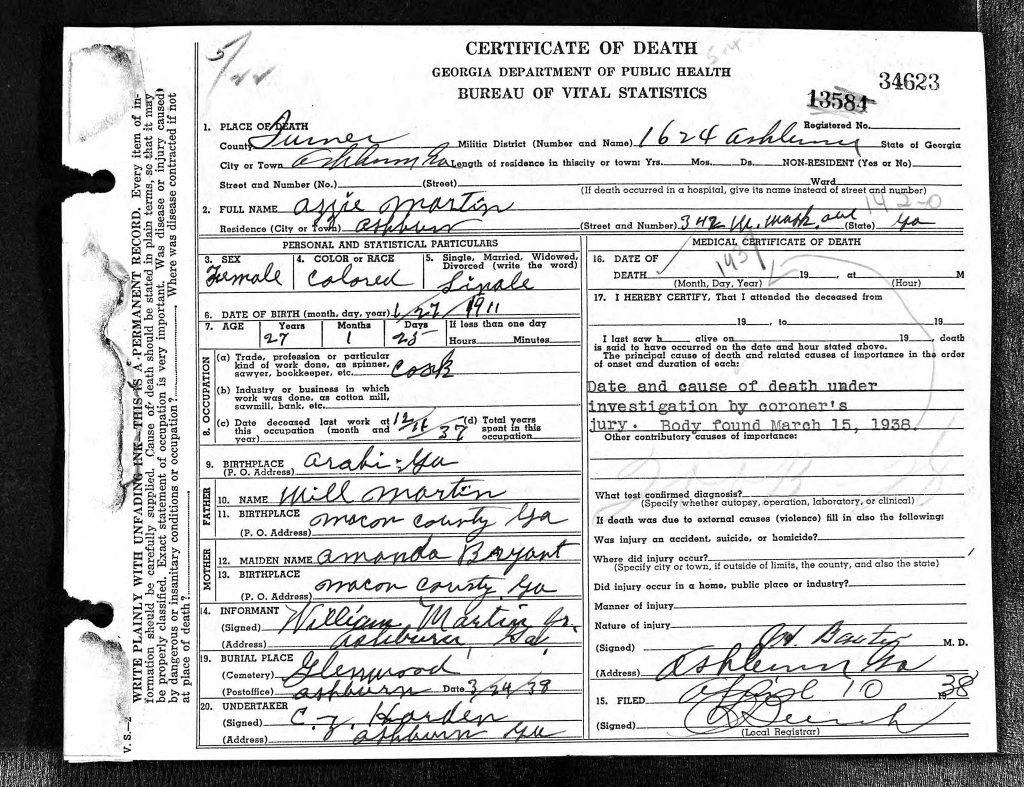
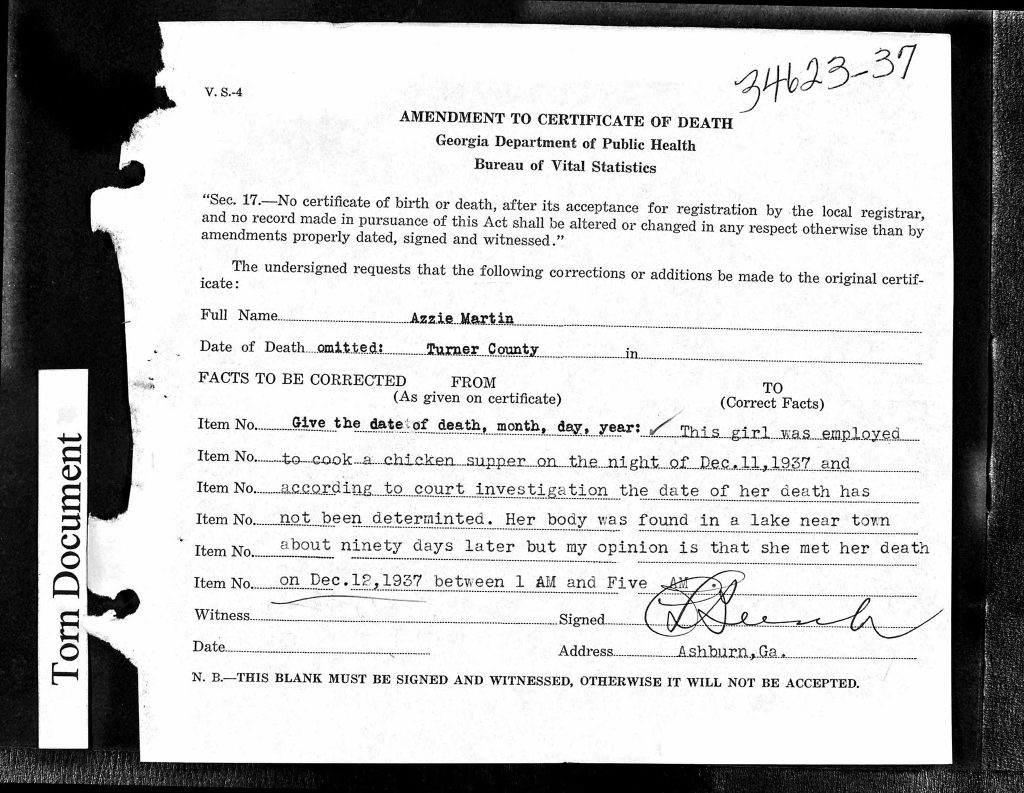
Other newspapers around the country report Azzie’s tragedy
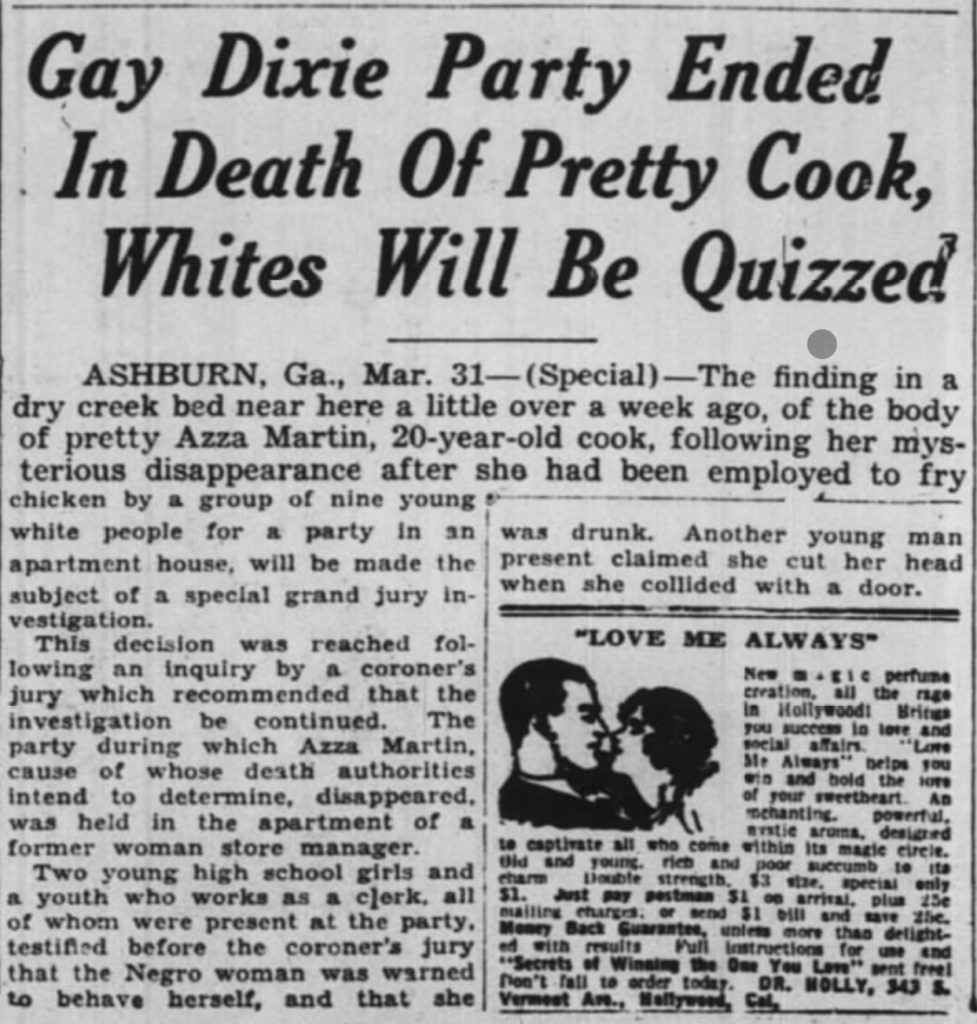
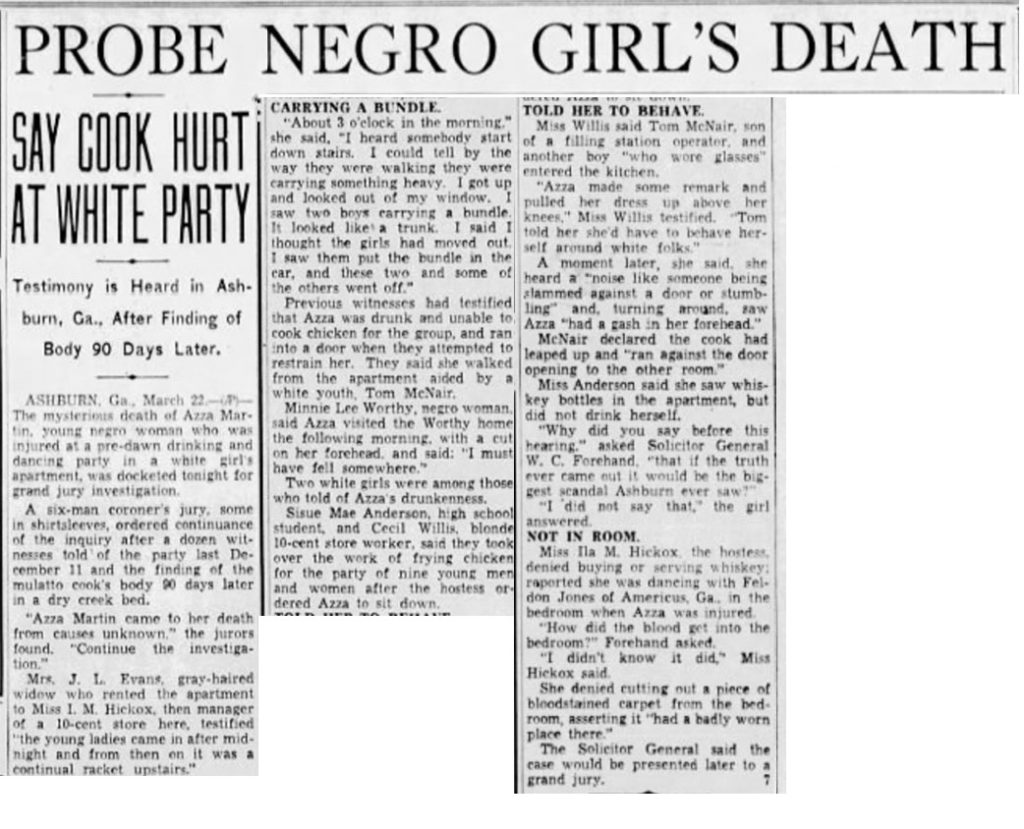
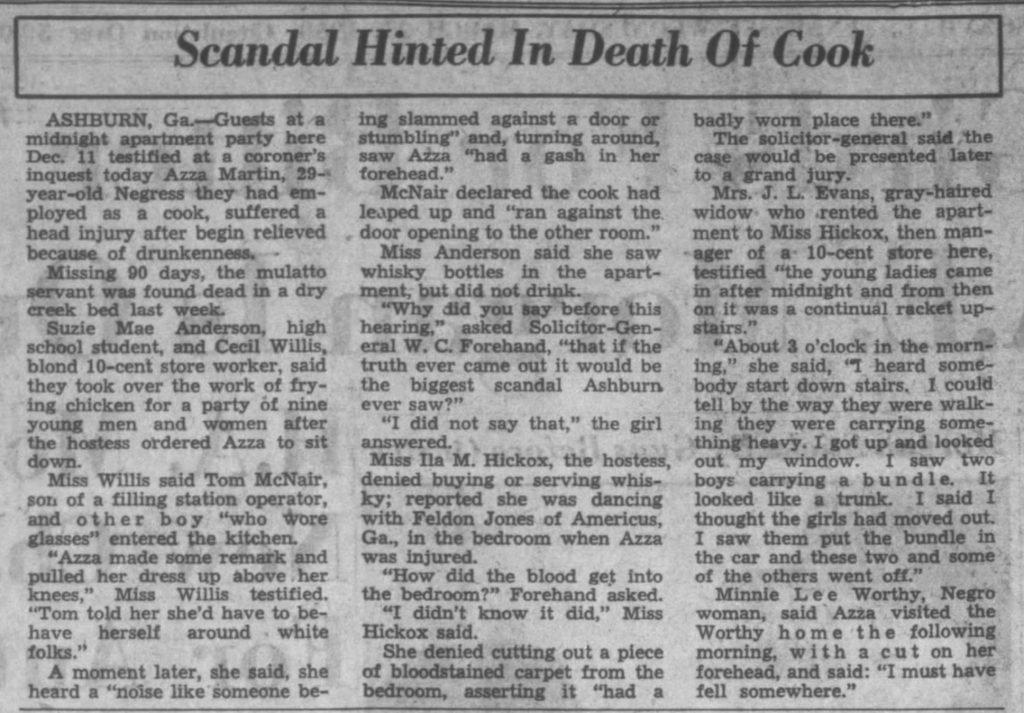
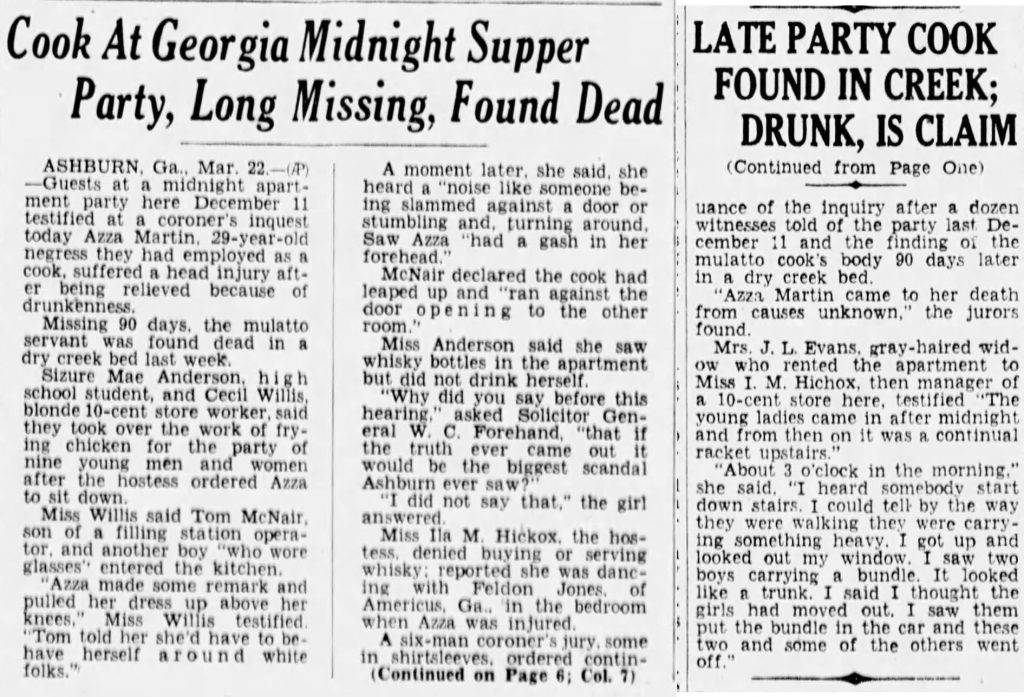
Conclusion of Azzie Martin’s Murder
Sadly, despite the efforts of the Turner County Project, neither the resolution of her murder nor the location of Azzie Martin’s grave has been found. The whereabouts of Glenwood Cemetery have been forgotten, even by those in the funeral business. Even more heartbreaking is the absence of investigation records to review, leaving the tragedy without closure and justice forever unresolved.
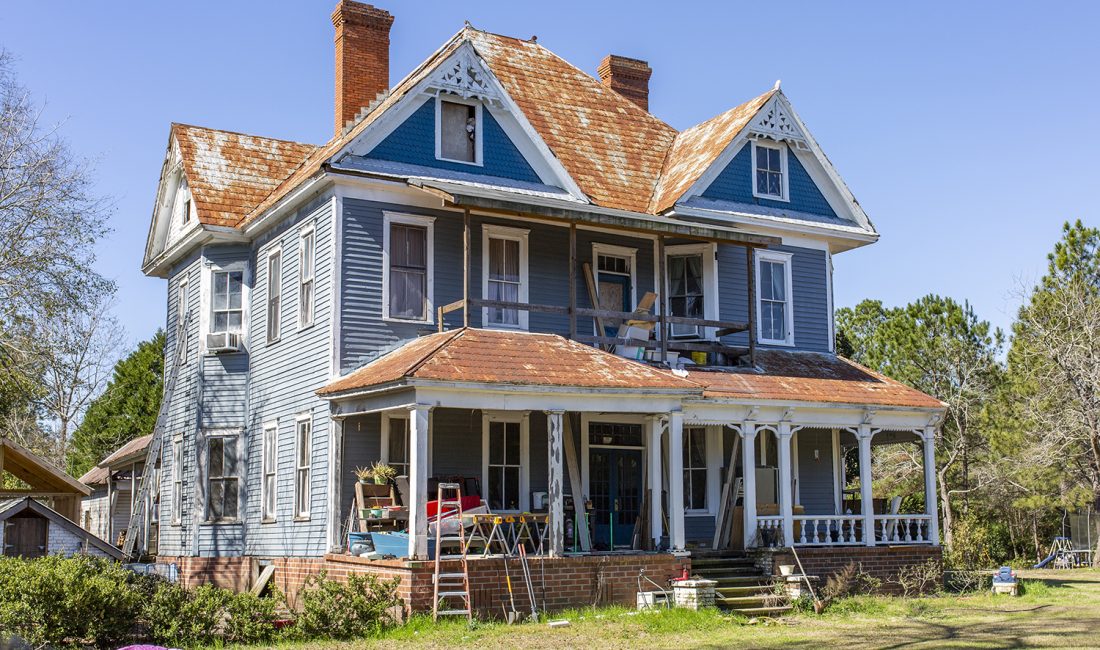
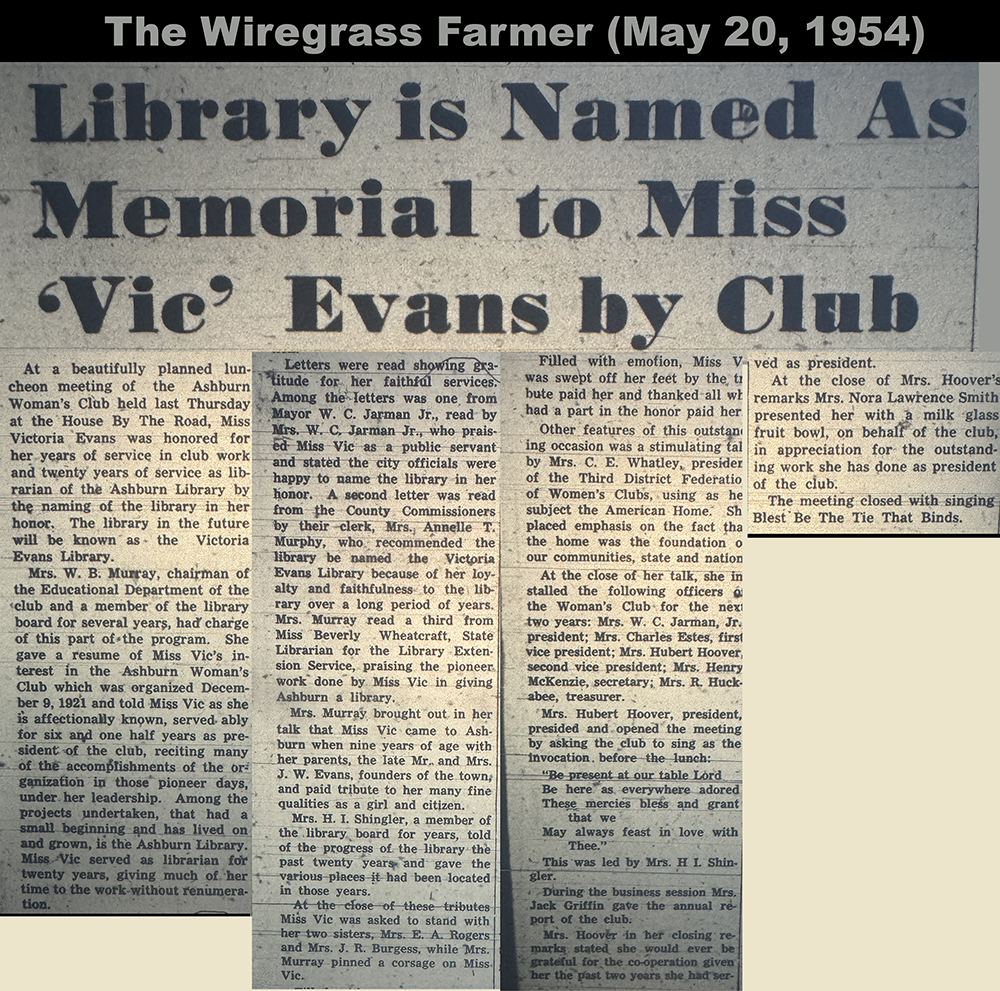
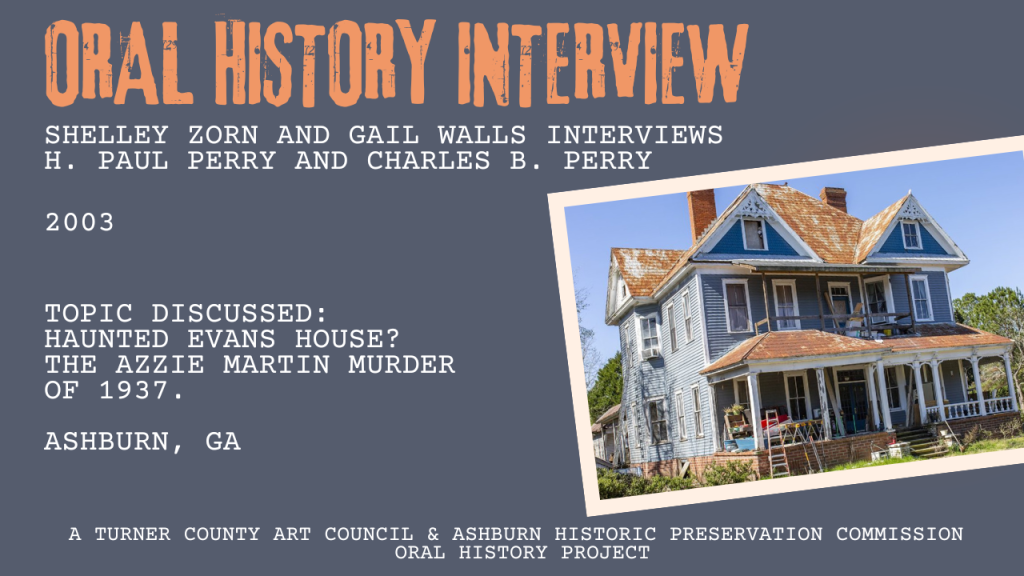

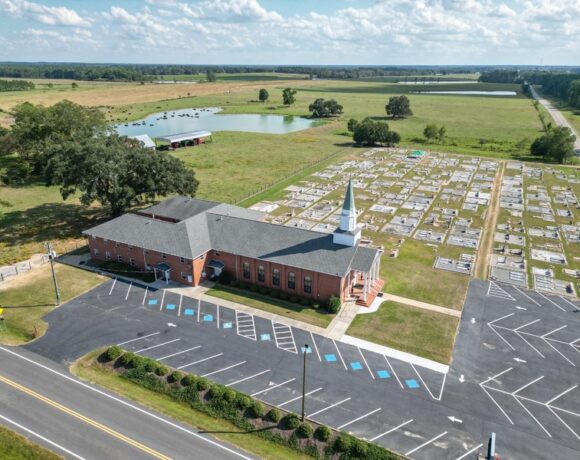
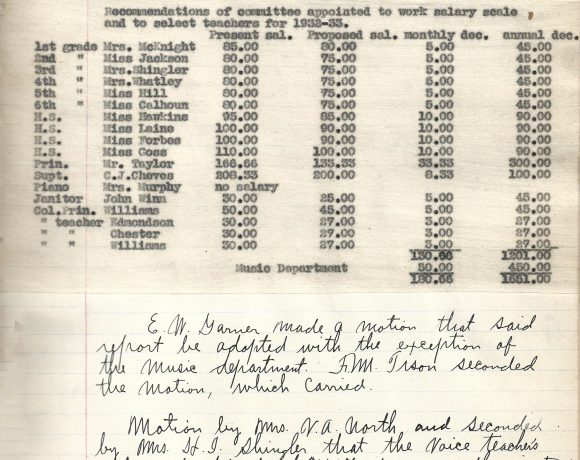
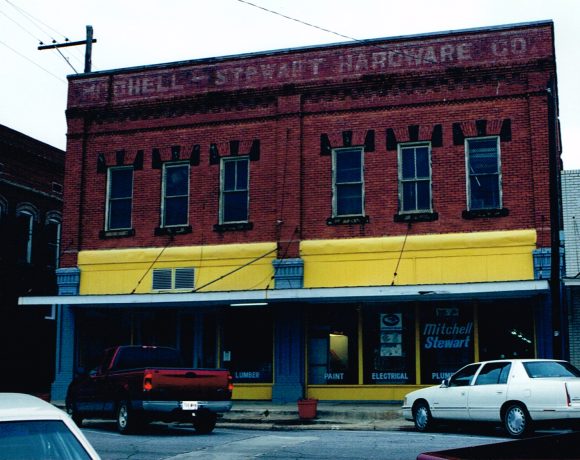
Leave a Reply